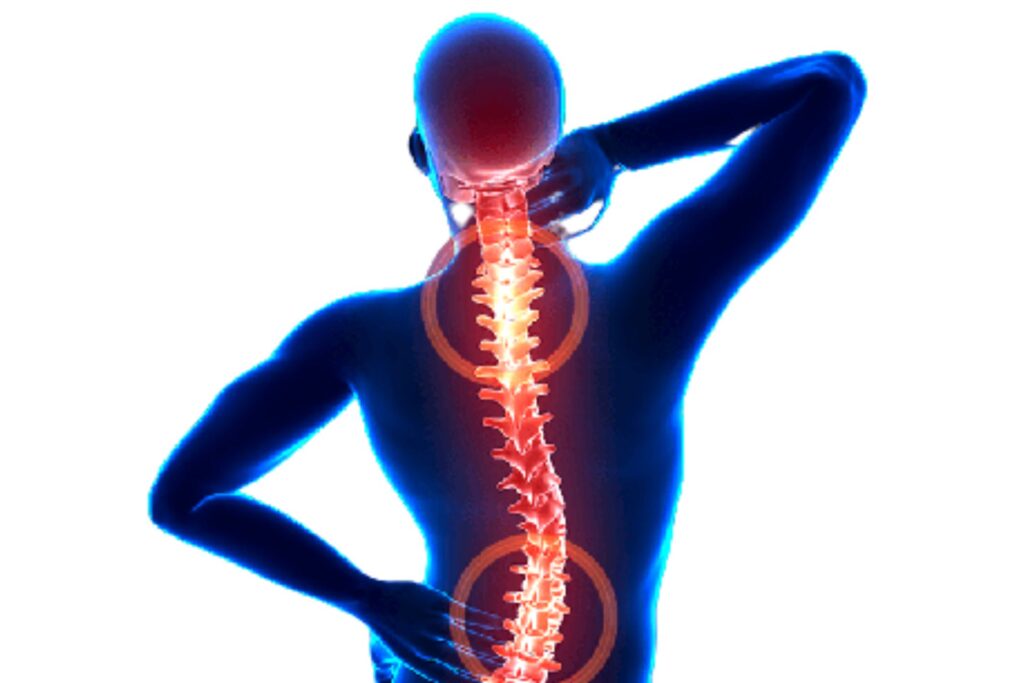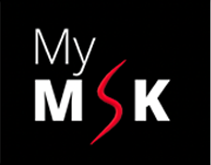Spine pain can arise from issues like herniated discs, spinal stenosis, muscle strains and Arthritis. Knowing what causes spine pain, common conditions and their treatments, is key to finding relief. Stopping treatment after pain subsides can lead to the loss of benefits within a few weeks, so ongoing management is crucial.
This article breaks down these conditions and their treatments to help you manage and reduce spine pain.
Key Takeaways
- Spine pain can arise from various sources, including herniated discs, spinal stenosis, muscle strains, and degenerative disc disease, each requiring tailored treatments.
- Accurate diagnosis of spine pain is crucial, and methods involve physical examinations, imaging techniques such a MRI scans can identify underlying conditions.
- Non-surgical treatments such as medications, physical therapy, and lifestyle modifications are often effective; however, surgical options may be necessary for severe cases.
- Stopping treatment or exercise after pain subsides can lead to the loss of benefits within a few weeks, emphasizing the need for ongoing activity even when one feels better.
Overview of Spine Pain
Spine pain, also known as back pain, is a common medical condition that affects millions of people worldwide. It can range from a dull, constant ache to a sudden, sharp pain that may shoot down the leg. Spine pain can be caused by a variety of factors, including mechanical or structural problems, muscle strain, or soft tissue damage. In some cases, spine pain can be a symptom of an underlying medical condition, such as spinal stenosis, herniated discs, or degenerative disc disease.
What is Spine Pain?
Spine pain, often referred to as back pain, is a prevalent issue that can significantly impact daily life. It can manifest as a persistent, dull ache or a sudden, sharp pain that may radiate down the leg. The causes of spine pain are diverse, ranging from mechanical or structural problems, such as misaligned vertebrae, to muscle strain or soft tissue damage. Conditions like spinal stenosis, where the spinal canal narrows, or herniated discs, where the disc material bulges out, can also lead to significant discomfort. Understanding the nature of your spine pain is crucial for effective treatment and management.
Anatomy of the Spine
Understanding the anatomy of the spine is essential for identifying the underlying causes of spine pain. The spine is a complex structure composed of bones, muscles, ligaments, and nerves, all working together to support the body and facilitate movement.
Understanding the Spinal Cord
The spinal cord is a vital part of the spine, extending from the base of the brain down to the lower back. It is a complex system of nerves that transmit signals between the brain and the rest of the body. The spinal cord is protected by the vertebrae, which are stacked on top of each other to form the spine. The spine is divided into three main regions: the cervical spine (neck), thoracic spine (upper back), and lumbar spine (lower back). Each region plays a crucial role in supporting the body and enabling movement. Understanding the spinal cord’s anatomy helps in diagnosing and treating spine pain effectively.
Common Spine Pain Conditions
Spine pain can originate from various sources, including muscles, bones, ligaments, the spinal cord, and nerves, or even internal organs.
The symptoms can vary widely, from a simple ache, tightness, or muscle spasm-like pain to deep and dull pain originating from the bones.
Identifying the specific condition behind your spine pain is key to effective treatment.
Here are some of the most common spine pain conditions.
Herniated Discs
A herniated disc occurs when the gel-like center of a spinal disc bulges out through a tear in the outer layer, often causing significant back pain. This condition can happen due to excessive strain or injury to the spine, and it commonly affects the lumbar spine and cervical spine.
The symptoms of a herniated disc include sharp pain, numbness, and weakness, which can radiate down the legs, a condition known as sciatica.
A herniated disc in the cervical spine can make certain neck movements painful, complicating daily activities.
The pain can vary in intensity and sometimes radiates to other body parts such as the shoulder or arms, a type of pain termed ‘referred pain’.
Treatments for herniated discs include physical therapy, pain relief medications, injections and, if necessary, discectomy.
Accurate diagnosis and timely treatment help manage symptoms and prevent further spinal damage.
Spinal Stenosis
Spinal stenosis is a condition where the spinal canal narrows, potentially compressing the spinal cord and nerve roots.
This narrowing can occur due to age-related wear and tear, particularly from arthritis, leading to severe pain and discomfort.
Symptoms of spinal stenosis often worsen over time and may include leg pain or cramping when standing or walking, as well as numbness and weakness in the legs or arms.
The patient may have to bend forward or sit down for several minutes before being able to walk a small distance again.
The lumbar region and cervical spine are commonly affected by spinal stenosis, and the condition can significantly impact one’s mobility and quality of life.
Spinal stenosis management typically includes physical therapy, medications, and, in severe instances, surgery to relieve spinal cord and nerve pressure.
Muscle Strains and Sprains
Muscle strains and sprains are common causes of low back pain, often resulting from abnormal stretching or tearing of muscle fibers or ligaments. Strains impact muscles or tendons.
Sprains are also related to ligaments. These injuries can lead to inflamed soft tissues, causing pain and muscle spasms that can make even simple movements challenging.
Lumbar muscle strains and sprains are particularly prevalent due to the significant stress placed on the lower back during everyday activities.
Treatment usually involves rest, physical therapy, and sometimes soft tissue therapy.
Core strength training exercises and stretches targeting back muscles can also prevent future injuries. However, stopping exercise after pain subsides can lead to the loss of benefits within a few weeks, suggesting the need for ongoing activity.
Degenerative Disc Disease
Degenerative disc disease is a condition where the spinal discs wear down over time, leading to chronic back pain.
This degenerative process can affect the any aspect of the spine especially the cervical or lumbar spine
This causes low back pain and reducing overall spine flexibility.
Lifestyle factors, such as smoking and weight gain, can exacerbate the degeneration by increasing the load on the spine and causing premature degeneration of the spinal discs.
Treatment for this condition often includes physical therapy, medications, and lifestyle changes to slow disease progression and reduce symptoms.
Diagnostic Methods for Spine Pain
Diagnosing Spine pain accurately is essential for determining the most effective treatment plan.
The nature, location and severity provide valuable insights into its underlying cause.
Diagnosing the cause of the pain typically include physical examinations and imaging techniques
Chronic Back Pain
Imaging Techniques
Imaging techniques are indispensable for diagnosing various spine conditions.
X-rays can help identify bone abnormalities in the spinal column, while MRIs are more effective at visualizing soft tissue structures such as disc or nerve.
CT scans provide detailed images that help identify problems with both bones better than soft tissues, making them essential tools for a comprehensive evaluation.
Medications
Medications are often the first line of treatment for spine pain.
Common initial treatments for mild to moderate pain include nonsteroidal anti-inflammatory drugs (NSAIDs) and paracetamol.
These over-the-counter medications can typically be used for about a week to 10 days to manage pain effectively.
Neuropathic painkillers such as amitryptilline or muscle relaxants may be needed for more severe pain symptoms.
Physical Therapy
Physical therapy is fundamental in non-surgical spine pain treatment, easing pain from injuries and posture issues, strengthening muscles, and improving flexibility.
Customised programs can effectively target and alleviate symptoms.
Regular physical therapy is vital to prevent back pain recurrence. Activities that strengthen core muscles support spinal health and reduce future pain risk. Stopping physical therapy after pain subsides can lead to the loss of benefits within a few weeks, highlighting the importance of ongoing therapy.
Lifestyle Modifications
Lifestyle modifications play a significant role in managing and preventing spine pain. Carrying excess body weight increases pressure on back joints, leading to pain.
Doctors may recommend dietary changes, exercise, or medications to address obesity-related back pain.
Maintaining good posture supports the spine and can significantly reduce pain.
Remaining in the same position for prolonged periods can negatively affect the back, making it essential to incorporate regular movement and exercise into everyday activities.
Regular exercise strengthens back muscles, helping to alleviate and prevent spine pain.
Non-Surgical Treatments for Spine Pain
Non-surgical treatments are often the first line of defense against spine pain, offering effective relief without the need for invasive procedures. These treatments focus on managing pain and improving function through various methods.
Pain Management Options
There are several non-surgical treatments for spine pain, including pain management options. These options may include:
- Pain medication: Over-the-counter pain medications, such as acetaminophen or ibuprofen, can help reduce pain and inflammation.
- Physical therapy: A physical therapist can help you develop a customized exercise program to strengthen your back muscles and improve flexibility.
- Heat or cold therapy: Applying heat or cold packs to the affected area can help reduce pain and stiffness.
- Rest: Getting plenty of rest and avoiding heavy lifting or bending can help reduce pain and promote healing.
- Alternative therapies: Alternative therapies, such as acupuncture or massage, may also be helpful in managing spine pain.
It’s essential to consult with a healthcare professional to determine the best course of treatment for your specific condition. They can help you develop a personalized treatment plan that addresses your unique needs and promotes optimal pain relief.
Surgical Treatments for Spine Pain
Surgical treatments are considered for individuals suffering from severe or persistent spine pain when non-surgical options have failed.
These treatments aim to alleviate pain and improve function, often providing significant relief for those with debilitating spine conditions.
Discectomy
Discectomy is a surgical procedure designed to remove herniated disc material that is pressing on nerve roots.
Patients suffering from severe pain due to herniated discs may be recommended for discectomy when conservative treatments fail.
During the procedure, the surgeon makes an incision near the spine to access the affected disc and remove the pressure-causing material.
Recovery from discectomy can vary, but many patients experience significant pain relief following the surgery and may return to normal activities within weeks to months. This procedure can be life-changing for those with severe pain that has not responded to other treatments.
Spinal Fusion
Spinal fusion aims to join two or more vertebrae to eliminate painful movement and stabilize the spine.
This procedure involves joining the vertebrae together, which can help reduce pain and improve stability for those with chronic back pain or spinal conditions.
Artificial Disc Replacement
Artificial disc replacement surgery involves removing a damaged disc and replacing it with a prosthetic to maintain motion. This procedure is typically recommended for individuals with back pain from one or two problematic intervertebral discs.
The surgery usually lasts 2 to 3 hours and involves accessing the spine through an incision in the abdomen.
By maintaining spinal flexibility, artificial disc replacement can provide significant relief and improve quality of life.
Home Remedies and Self-Care
Implementing home remedies and self-care practices can effectively manage spine pain and prevent it from worsening.
Simple techniques such as heat and ice therapy, exercise, and proper ergonomics can provide significant pain relief and improve overall spine health.
Heat and Ice Therapy
Applying heat to the affected area can help relieve pain. It also reduces stiffness in the muscles or joints.
Methods for heat therapy include using a reusable heat pad, microwavable wheat bag, or hot-water bottle.
Alternating heat and ice therapy for 15-20 minutes is recommended for pain relief. Use a tea towel to protect your skin.
Exercise and Stretching
Engaging in regular stretching can enhance back flexibility and decrease pain levels. Incorporating stretching exercises, held for at least 30 seconds, can effectively relieve lower back discomfort.
Exercise strengthens back muscles and supports spine health. Stopping exercise after pain subsides can lead to the loss of benefits within a few weeks, so ongoing activity is essential.
Proper Ergonomics
Proper ergonomics at home and work help prevent back pain. Adjusting your workstation to have the computer screen at eye level reduces strain.
Using back support devices, ergonomic chairs, and aligning your workspace properly are essential to prevent back pain.
These adjustments maintain good posture and support the spine, reducing pain and injury risk.
When to Seek Medical Help
Recognizing when to seek medical help for spine pain is crucial to avoid serious complications.
Persistent back pain despite treatment warrants a doctor’s consultation.
Persistent or worsening lower back pain symptoms necessitate professional evaluation to determine the underlying cause and appropriate treatment.
Red Flags
Certain warning signs or “red flags” require immediate medical attention to prevent serious complications.
Loss of bowel or bladder control is a critical symptom that necessitates urgent medical evaluation.
Pain that radiates down one or both legs can indicate nerve involvement and should prompt a visit to a healthcare provider.
Recognising these red flags and seeking timely medical help is crucial for accurate diagnosis and treatment.
Persistent Pain
Persistent spine pain that does not respond to home treatments or over-the-counter pain medication should be addressed by a clinician
Severe lower back pain that interferes with daily activities or exercise requires medical attention.
If you’re struggling to manage your pain or if your pain worse over time, consulting a GP or physiotherapist is crucial for tailored exercise advice and further evaluation.
Preventing Spine Pain
Prevention is always better than cure, especially when it comes to spine pain.
Maintaining good posture, engaging in regular exercise, and making healthy lifestyle choices are key strategies for preventing spine pain.
Incorporating these habits into your daily routine can significantly reduce the risk of developing chronic back pain. Stopping these preventive measures after pain subsides can lead to the loss of benefits within a few weeks, so ongoing activity is essential.
Safe Lifting Techniques
Safe lifting techniques are crucial to prevent back strain. When lifting heavy objects, squat and use your legs instead of your back, engaging your leg muscles during heavy lifting.
Using proper lifting techniques protects your spine from stress and injury.
Avoiding Heavy Lifting
Summary
Understanding the causes and treatments for spine pain is essential for effective management and prevention. From recognizing common spine conditions to exploring diagnostic methods and treatment options, being informed empowers you to take control of your spine health.
Implementing preventive measures and seeking timely medical help can significantly improve your quality of life.
Frequently Asked Questions
What is the best treatment for spine pain?
The best treatment for spine pain often includes nonsurgical methods such as acupuncture, massage, and electrical nerve stimulation, which can significantly alleviate chronic back pain with minimal risks. Pursuing these therapies is advisable for effective pain management.
What are the common symptoms of a herniated disc?
Common symptoms of a herniated disc include pain, numbness, and weakness, often radiating down the legs, known as sciatica. It is essential to address these symptoms promptly for effective management.
When should I seek medical help for spine pain?
Seek medical help for spine pain if it persists for a few weeks despite home treatment, worsens, or is accompanied by red flag symptoms such as loss of bowel or bladder control or radiating pain down the legs.
What non-surgical treatments are available for spine pain?
Non-surgical treatments for spine pain encompass medications, physical therapy, and lifestyle modifications, including good posture and regular exercise. These options can effectively alleviate pain and improve overall spine health.
How can I prevent spine pain?
To prevent spine pain, it is essential to maintain good posture, engage in regular exercise, practice safe lifting techniques, and adopt healthy lifestyle choices to sustain a healthy weight. These proactive measures can significantly reduce the risk of spinal discomfort.





